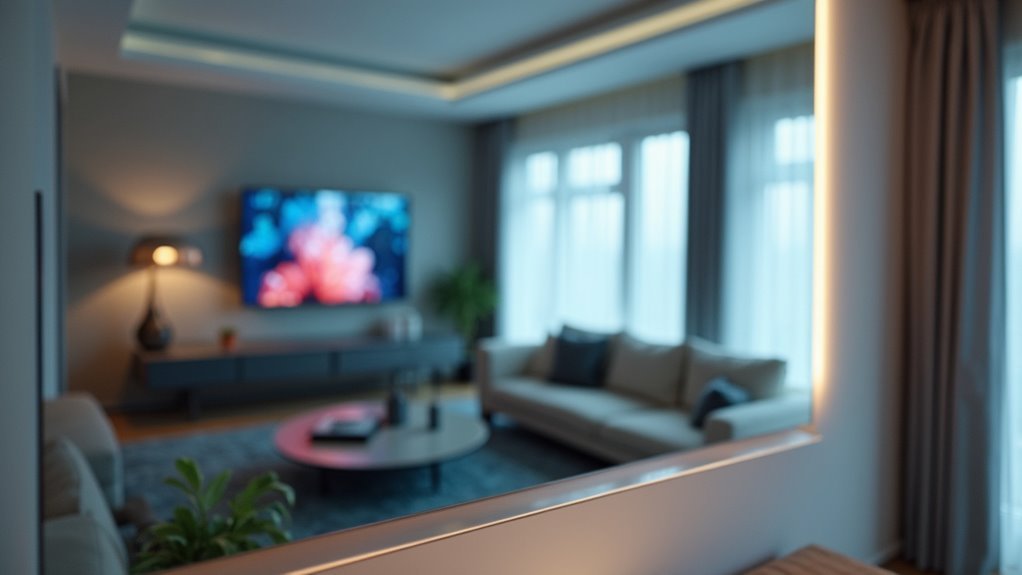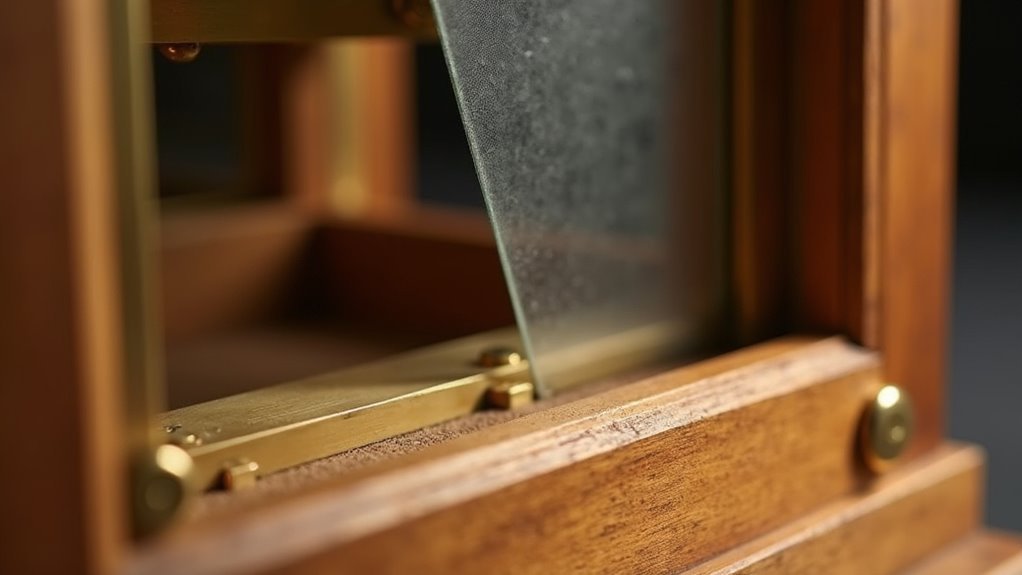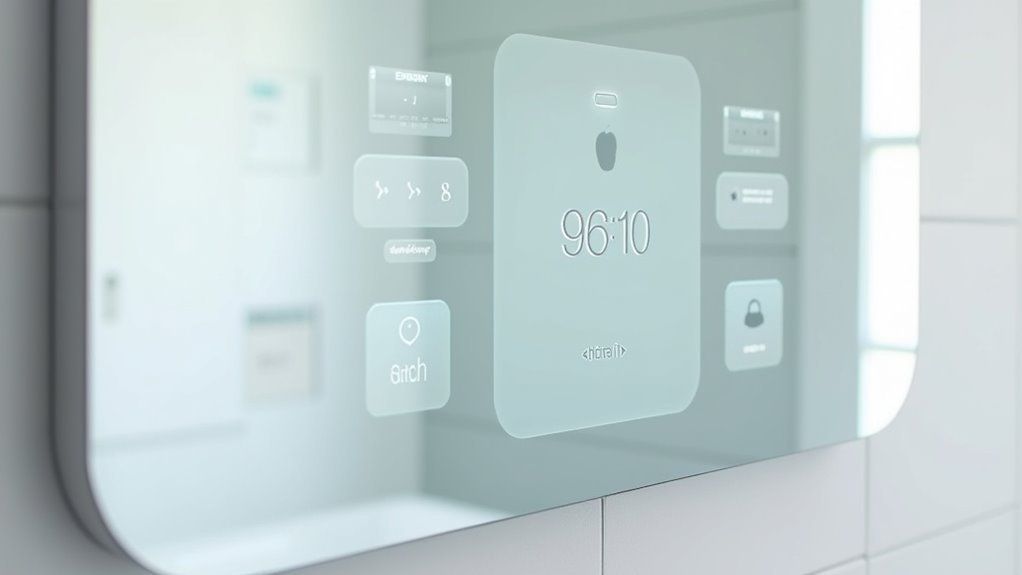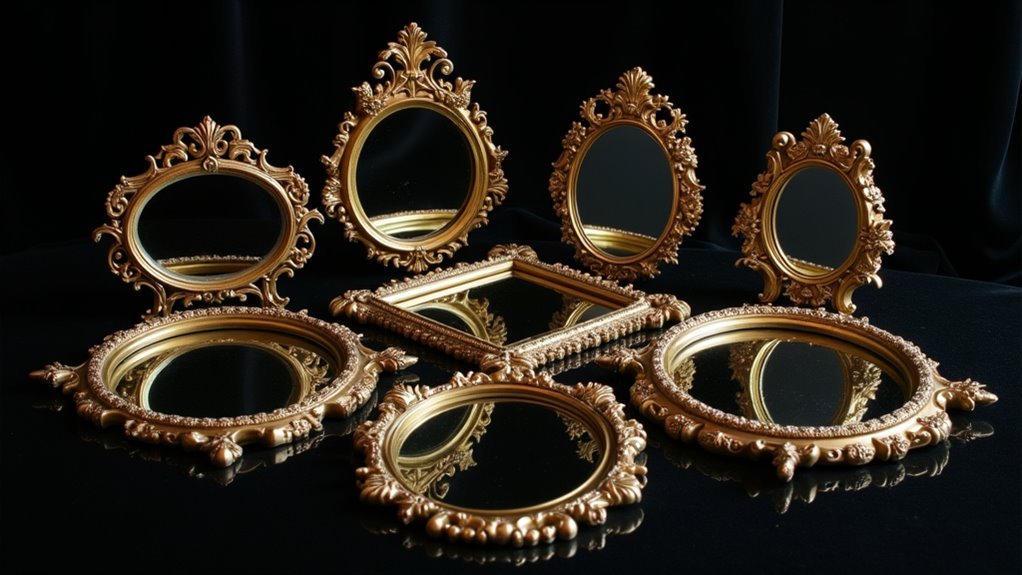You’ve probably watched someone interact with what appears to be an ordinary mirror, only to see it suddenly light up with digital content. These concealed smart displays aren’t just sci-fi magic—they’re surprisingly achievable DIY projects that’ll transform any room into something extraordinary. The secret lies in mastering seven specific techniques that seamlessly blend technology with optical illusion. Once you understand how two-way mirrors work with hidden screens, you’ll never look at reflective surfaces the same way again.
Selecting the Right Two-Way Mirror for Your Smart Display

When building a smart mirror, you’ll need to choose a two-way mirror that balances optical clarity with reflective properties. The optical quality determines how clearly your display shows through while maintaining the mirror’s reflective surface.
Select thickness between 1/8 to 1/4 inch, considering that thicker mirrors offer better durability but may reduce clarity.
Lighting conditions greatly impact performance. Two-way mirrors work best when the reflective side receives more illumination than the display side. Position your smart mirror in well-lit areas for ideal results.
Choose mirrors with anti-glare coatings to enhance viewing in varying light conditions.
Size the mirror to match your display’s dimensions, avoiding gaps or excessive framing that disrupts the seamless integration you’re aiming for.
Preparing Your Display Screen for Mirror Integration
You’ll need to position your display screen at the ideal angle to work seamlessly with your two-way mirror setup.
Start by adjusting the screen’s tilt and rotation until the reflective properties align perfectly with your surrounding mirrors.
Next, configure your lighting control system to eliminate glare and guarantee the display content remains visible while maintaining the mirror’s illusion.
Screen Angle Adjustment
Three critical factors determine whether your mirror magic trick succeeds or fails spectacularly: screen angle, distance, and height positioning. You’ll need to experiment with various positions to eliminate glare while maximizing the illusion’s effectiveness. I thought I’d emphasize that adjustable mounts are essential—they’ll save you countless headaches during setup.
| Angle Range | Distance | Visibility | Glare Level | Illusion Quality |
|---|---|---|---|---|
| 15-30° | Close | Excellent | High | Strong |
| 30-45° | Medium | Good | Medium | Ideal |
| 45-60° | Medium | Fair | Low | Good |
| 60-75° | Far | Poor | Minimal | Weak |
| 75-90° | Far | Very Poor | None | Failed |
Test everything beforehand—I’m going to show you that preparation prevents disaster. Let me know if you discover the sweet spot where reflections disappear completely.
Lighting Control Setup
Four essential lighting elements transform your basic mirror setup into a professional-grade illusion platform.
First, position adjustable lights to control brightness and shadows, creating dramatic effects while preventing disruptive glare. You’ll want to eliminate harsh shadows by incorporating soft diffused lights around your display area, guaranteeing uniform illumination that complements your mirror configuration.
Next, experiment with colored gels or filters on your lights to add unique visual dynamics that enrich your audience’s experience. The interplay between colored lighting and mirror reflections creates depth and mystery that captivates viewers.
Finally, always test your lighting setup before performing. This guarantees reflections enhance rather than detract from your illusion. Proper lighting coordination makes the difference between amateur tricks and professional mirror magic performances.
Building the Frame Structure to House Both Components

You’ll need to construct a robust frame that can support both your display screen and mirrors without compromising stability.
Your structural support requirements include using high-quality materials like plywood or MDF, reinforcing joints with corner brackets, and adding proper backing to prevent wobbling.
You must also plan your mirror positioning techniques carefully, ensuring accurate measurements and using a level during assembly to maintain perfect alignment for clear reflections.
Structural Support Requirements
When constructing a frame for mirror magic tricks, you’ll need to prioritize structural integrity above all else. Your frame must support the mirrors’ weight plus any additional components without failing during performance. Choose materials like wood or metal that exceed your combined component weight requirements.
| Support Element | Requirement |
|---|---|
| Joint Reinforcement | Double-reinforced corners |
| Weight Capacity | Exceeds combined mirror weight |
| Bracket System | Adjustable positioning mounts |
| Alignment Tool | Level for perfect assembly |
You’ll want to double-reinforce all joints and corners to prevent wobbling or structural failure. Install adjustable brackets within the frame for precise mirror positioning across different illusion setups. During assembly, use a level to guarantee perfect alignment—even slight misalignments will distort reflections and compromise your illusion’s effectiveness.
Mirror Positioning Techniques
Strategic mirror placement within your adjustable frame system determines the success of your illusion. Position mirrors at calculated angles that reflect essential display elements while hiding others, creating compelling depth and mystery.
You’ll need clean, high-quality mirrors since smudges or imperfections will destroy the effect immediately.
Experiment with various mirror sizes and shapes to dramatically alter spatial perception and viewer experience. Your adjustable frame allows you to test different angles until you achieve peak visual impact.
Install a contrasting backing behind the mirrors to define the illusion boundaries and eliminate unwanted reflections.
Focus on reflecting key components while concealing the mechanics of your trick. The right positioning transforms ordinary objects into extraordinary illusions that captivate audiences through strategic visual manipulation.
Wiring and Connecting Your Hidden Smart Display System
Since your smart display forms the heart of your mirror magic trick, you’ll need to choose one that supports HDMI connectivity and fits perfectly within your mirror frame dimensions.
Install a two-way mirror that allows images to shine through while maintaining the mirror illusion when your display’s off.
Connect your display to power and use an HDMI splitter if you’re running multiple devices without quality loss.
You’ll want to conceal all wiring by running cables through walls or using cable management solutions for a clean appearance.
Test visibility and reflection effects under different lighting conditions.
Adjust brightness settings accordingly to optimize your viewing experience.
This guarantees your hidden display performs flawlessly while preserving the mirror’s magical appearance throughout various ambient lighting scenarios.
Programming Display Brightness for Optimal Mirror Visibility

After completing your wiring setup, fine-tuning your display’s brightness becomes your next priority for achieving seamless mirror magic effects.
You’ll want to adjust brightness between 70-80% for ideal visibility without creating unwanted glare. Position your display at an angle that minimizes reflections from surrounding light sources to enhance content clarity.
Use a color calibration tool to guarantee vibrant, true-to-life colors that’ll create maximum visual impact when viewed through the mirror.
Don’t forget to experiment with contrast and saturation settings until you find the perfect combination that maximizes visibility without image distortion.
Remember to regularly clean your mirror surface, removing smudges and dust that can diminish display visibility and create distracting artifacts during your performances.
Mounting Your Concealed Smart Mirror Display Unit
Everything depends on proper mounting when creating your concealed smart mirror display unit.
Proper mounting forms the foundation of any successful smart mirror installation and determines both safety and long-term performance.
You’ll need to choose a location with stable wall structure that can support the mirror’s weight and electronic components. Use a level to mark your desired height, typically at eye level, for the best viewing experience.
Securely attach mounting brackets to the wall, anchoring them into studs or using appropriate wall anchors for drywall to prevent sagging. This guarantees your mirror won’t fall or shift over time.
Conceal all wiring using cable management solutions like raceways or conduits that you can paint to match your wall, maintaining clean aesthetics.
After installation, test your smart mirror’s functionality to verify it operates correctly and reflections appear without distortion.
Testing and Calibrating Your Hidden Display Performance
Precision becomes paramount once you’ve mounted your concealed smart mirror display unit and need to verify its performance.
Start by optimizing mirror angles and positioning to create your desired illusion without exposing the hidden display. Test under various lighting conditions since different intensities and angles dramatically affect visibility and impact.
Check regularly for reflective distortions from mirrors, as minor imperfections can disrupt the illusion’s effectiveness.
You’ll want to incorporate real-time audience feedback during calibration sessions to identify confusion or clarity issues with your hidden display’s performance.
Document each configuration’s results during practice sessions, noting which setups produced the most convincing illusions.
This documentation becomes invaluable for future reference and refinement of your mirror magic display system.
Frequently Asked Questions
How to Use Mirrors to Make Something Invisible?
You’ll position a mirror at a specific angle to create a reflective barrier that hides objects from view. Adjust the distance and lighting carefully, then add patterned backgrounds to enhance the invisibility illusion effect.
How Can a Mirror See You if You Have a Towel in Front of You?
A mirror can’t see you if you’re completely behind a towel. It only reflects light that reaches it, so the towel blocks your reflection from appearing in the mirror’s surface.
What Is the Mirror Trend on Tiktok?
You’ll find TikTok’s mirror trend creates stunning visual illusions using strategic mirror placement. You can make infinity effects, perspective tricks, and surprising transformations that’ll captivate viewers through creative positioning and clever editing techniques.
How Can a Mirror See Something Hidden?
You’re positioning a mirror at strategic angles to reflect objects that aren’t directly visible to your eye. The mirror’s surface redirects light from hidden items, making them appear in the reflection.





Leave a Reply